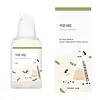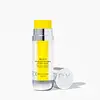What's inside
What's inside
 Key Ingredients
Key Ingredients

 Benefits
Benefits

 Concerns
Concerns

 Ingredients Side-by-side
Ingredients Side-by-side

Water
Skin ConditioningPropanediol
SolventGlycerin
HumectantGlycereth-26
Humectant1,2-Hexanediol
Skin ConditioningCoco-Caprylate/Caprate
EmollientPanthenol
Skin ConditioningGlycine Max Seed Extract
Skin ConditioningSqualane
EmollientCeramide NP
Skin ConditioningCeramide Ns
Skin ConditioningCeramide AP
Skin ConditioningCeramide As
Skin ConditioningCeramide EOP
Skin ConditioningHydrogenated Lecithin
EmulsifyingStearic Acid
CleansingPhytosphingosine
Skin ConditioningCetearyl Alcohol
EmollientCholesterol
EmollientAdenosine
Skin ConditioningLactobacillus/Soymilk Ferment Filtrate
Skin ConditioningLactobacillus/Rye Flour Ferment
Skin ConditioningBacillus/Soybean Ferment Extract
Skin ConditioningPantothenic Acid
Skin ConditioningFolic Acid
Skin ConditioningPyridoxine
Skin ConditioningThiamine Hcl
MaskingRiboflavin
Cosmetic ColorantCyanocobalamin
Skin ConditioningHydroxydecyl Ubiquinone
AntioxidantNiacinamide
SmoothingTetradecyl Aminobutyroylvalylaminobutyric Urea Trifluoroacetate
Skin ConditioningDipeptide Diaminobutyroyl Benzylamide Diacetate
Skin ConditioningBetaine
HumectantTrehalose
HumectantEthylhexylglycerin
Skin ConditioningPolyacrylate Crosspolymer-6
Emulsion StabilisingAcrylates/C10-30 Alkyl Acrylate Crosspolymer
Emulsion StabilisingGlyceryl Stearate Citrate
EmollientButylene Glycol
HumectantTocopherol
AntioxidantTheobroma Cacao Seed Extract
AntioxidantPolyglyceryl-3 Distearate
EmulsifyingTromethamine
BufferingZea Mays Starch
AbsorbentMicrocrystalline Cellulose
AbsorbentAscorbyl Glucoside
AntioxidantKaolin
AbrasiveDextrin
AbsorbentMagnesium Chloride
Mannitol
HumectantXanthan Gum
EmulsifyingWater, Propanediol, Glycerin, Glycereth-26, 1,2-Hexanediol, Coco-Caprylate/Caprate, Panthenol, Glycine Max Seed Extract, Squalane, Ceramide NP, Ceramide Ns, Ceramide AP, Ceramide As, Ceramide EOP, Hydrogenated Lecithin, Stearic Acid, Phytosphingosine, Cetearyl Alcohol, Cholesterol, Adenosine, Lactobacillus/Soymilk Ferment Filtrate, Lactobacillus/Rye Flour Ferment, Bacillus/Soybean Ferment Extract, Pantothenic Acid, Folic Acid, Pyridoxine, Thiamine Hcl, Riboflavin, Cyanocobalamin, Hydroxydecyl Ubiquinone, Niacinamide, Tetradecyl Aminobutyroylvalylaminobutyric Urea Trifluoroacetate, Dipeptide Diaminobutyroyl Benzylamide Diacetate, Betaine, Trehalose, Ethylhexylglycerin, Polyacrylate Crosspolymer-6, Acrylates/C10-30 Alkyl Acrylate Crosspolymer, Glyceryl Stearate Citrate, Butylene Glycol, Tocopherol, Theobroma Cacao Seed Extract, Polyglyceryl-3 Distearate, Tromethamine, Zea Mays Starch, Microcrystalline Cellulose, Ascorbyl Glucoside, Kaolin, Dextrin, Magnesium Chloride, Mannitol, Xanthan Gum
Water
Skin ConditioningCoco-Caprylate/Caprate
EmollientCetearyl Isononanoate
EmollientPropanediol
SolventGlycerin
HumectantGlyceryl Stearate Citrate
Emollient3-O-Ethyl Ascorbic Acid
Skin ConditioningCaprylic/Capric Triglyceride
MaskingPolyglyceryl-3 Stearate
EmulsifyingDiglycerin
HumectantPolyglyceryl-10 Pentaisostearate
EmollientButylene Glycol
HumectantC9-12 Alkane
SolventHydrogenated Lecithin
EmulsifyingTetrahexyldecyl Ascorbate
AntioxidantCaprylyl Glycol
Emollient1,2-Hexanediol
Skin ConditioningHydroxyacetophenone
AntioxidantSodium Stearoyl Glutamate
CleansingXanthan Gum
EmulsifyingCarbomer
Emulsion StabilisingEthylhexylglycerin
Skin ConditioningSodium Hydroxide
BufferingCucumis Sativus Extract
Skin ConditioningPhospholipids
Skin ConditioningPolyglutamic Acid
Skin ConditioningIron Oxides
CI 77492
Cosmetic ColorantSclerotium Gum
Emulsion StabilisingLecithin
EmollientMaltodextrin
AbsorbentPhyllanthus Emblica Fruit Extract
HumectantPullulan
2,3-Butanediol
HumectantSilica
AbrasiveArbutin
AntioxidantHydrolyzed Soy Protein
HumectantTocopherol
AntioxidantRice Amino Acids
Skin ConditioningLinseed Acid
CleansingTocopheryl Acetate
AntioxidantGlyceryl Stearate
EmollientLactose
HumectantMilk Protein
Skin ConditioningBifida Ferment Lysate
Skin ConditioningGlutathione
Proline
Skin ConditioningSodium Carbonate
BufferingCaprae Lac
Skin ConditioningCeramide Ns
Skin ConditioningCeramide As
Skin ConditioningCeramide AP
Skin ConditioningCholesterol
EmollientHydrolyzed Adansonia Digitata Seed Extract
Sodium Benzoate
MaskingNephelium Lappaceum Peel Extract
Skin ConditioningAscorbyl Palmitate
AntioxidantHexapeptide-9
Skin ConditioningNicotiana Benthamiana Hexapeptide-40 Sh-Polypeptide-76
Skin ConditioningCeramide EOP
Skin ConditioningWater, Coco-Caprylate/Caprate, Cetearyl Isononanoate, Propanediol, Glycerin, Glyceryl Stearate Citrate, 3-O-Ethyl Ascorbic Acid, Caprylic/Capric Triglyceride, Polyglyceryl-3 Stearate, Diglycerin, Polyglyceryl-10 Pentaisostearate, Butylene Glycol, C9-12 Alkane, Hydrogenated Lecithin, Tetrahexyldecyl Ascorbate, Caprylyl Glycol, 1,2-Hexanediol, Hydroxyacetophenone, Sodium Stearoyl Glutamate, Xanthan Gum, Carbomer, Ethylhexylglycerin, Sodium Hydroxide, Cucumis Sativus Extract, Phospholipids, Polyglutamic Acid, Iron Oxides, CI 77492, Sclerotium Gum, Lecithin, Maltodextrin, Phyllanthus Emblica Fruit Extract, Pullulan, 2,3-Butanediol, Silica, Arbutin, Hydrolyzed Soy Protein, Tocopherol, Rice Amino Acids, Linseed Acid, Tocopheryl Acetate, Glyceryl Stearate, Lactose, Milk Protein, Bifida Ferment Lysate, Glutathione, Proline, Sodium Carbonate, Caprae Lac, Ceramide Ns, Ceramide As, Ceramide AP, Cholesterol, Hydrolyzed Adansonia Digitata Seed Extract, Sodium Benzoate, Nephelium Lappaceum Peel Extract, Ascorbyl Palmitate, Hexapeptide-9, Nicotiana Benthamiana Hexapeptide-40 Sh-Polypeptide-76, Ceramide EOP
 Reviews
Reviews

Ingredients Explained
These ingredients are found in both products.
Ingredients higher up in an ingredient list are typically present in a larger amount.
1,2-Hexanediol is a synthetic liquid and another multi-functional powerhouse.
It is a:
- Humectant, drawing moisture into the skin
- Emollient, helping to soften skin
- Solvent, dispersing and stabilizing formulas
- Preservative booster, enhancing the antimicrobial activity of other preservatives
Butylene Glycol (or BG) is used within cosmetic products for a few different reasons:
Overall, Butylene Glycol is a safe and well-rounded ingredient that works well with other ingredients.
Though this ingredient works well with most skin types, some people with sensitive skin may experience a reaction such as allergic rashes, closed comedones, or itchiness.
Learn more about Butylene GlycolCeramide AP is a type of Ceramide.
Ceramides are intercellular lipids naturally found in our skin that bonds dead skin cells together to create a barrier. Having a strong skin barrier leads to more firm and hydrated skin.
They are known for their ability to hold water and thus are a great ingredient for dry skin. By bolstering the skin ceramides act as a barrier against irritating ingredients. This can help with inflammation as well.
If you would like to eat ceramides, sweet potatoes contain a small amount.
Read more about other common types of ceramides here:
Ceramide NP
Ceramide EOP
Ceramide AS is a type of Ceramide.
Ceramides are intercellular lipids naturally found in our skin that bonds dead skin cells together to create a barrier. They are known for their ability to hold water and thus are a great ingredient for dry skin.
Ceramide EOP is a type of Ceramide.
EOP stands for a linked Ester fatty acid, a linked Omega hydroxy fatty acid, and the Phytosphingosine base.
Ceramides are intercellular lipids naturally found in our skin. They bind dead skin cells together to create a barrier. The ceramides in our skin have the ability to hold water to keep our skin hydrated.
Ceramides are an important building block for our skin barrier. A strong skin barrier helps with:
If you would like to eat ceramides, sweet potatoes contain a small amount.
Read more about other common types of ceramides here:
Learn more about Ceramide EOPCeramide NS is a type of Ceramide.
Ceramides are intercellular lipids naturally found in our skin that bonds dead skin cells together to create a barrier. They are known for their ability to hold water and thus are a great ingredient for dry skin.
Ceramide NG,Ceramide NS,1,3-Hexadecanediol, 2-Hexadecanamide,Palmitoyl-C16-Dihydrosphingosine,1-Stearoyl-C18-Sphingosine
Cholesterol is a class of organic molecules called lipids. It helps hydrate your skin and is essential to having a healthy skin barrier.
Our skin naturally contains cholesterol in the outermost layer. Besides cholesterol, it also contains ceramides and fatty acids. Cholesterol makes up about 1/4 of your skin's outer layer and barrier. Your skin barrier is responsible for keeping allergens and microbes out. Having a healthy skin barrier is also responsible for keeping your skin firm and plump.
Our bodies use cholestrol to create vitamin D, steroid hormones, and more.
Learn more about CholesterolCoco-Caprylate/Caprate is created from fatty coconut alcohol, caprylic acid, and capric acid.
It is a lightweight emollient. Emollients create a thin barrier on the skin to trap moisture in. This helps keep your skin hydrated and soft.
Once applied, Coco-Caprylate/Caprate is absorbed quickly and leaves a silky feel.
Coco-Caprylate/Caprate may not be fungal acne safe.
Learn more about Coco-Caprylate/CaprateEthylhexylglycerin (we can't pronounce this either) is commonly used as a preservative and skin softener. It is derived from glyceryl.
You might see Ethylhexylglycerin often paired with other preservatives such as phenoxyethanol. Ethylhexylglycerin has been found to increase the effectiveness of these other preservatives.
Glycerin is already naturally found in your skin. It helps moisturize and protect your skin.
A study from 2016 found glycerin to be more effective as a humectant than AHAs and hyaluronic acid.
As a humectant, it helps the skin stay hydrated by pulling moisture to your skin. The low molecular weight of glycerin allows it to pull moisture into the deeper layers of your skin.
Hydrated skin improves your skin barrier; Your skin barrier helps protect against irritants and bacteria.
Glycerin has also been found to have antimicrobial and antiviral properties. Due to these properties, glycerin is often used in wound and burn treatments.
In cosmetics, glycerin is usually derived from plants such as soybean or palm. However, it can also be sourced from animals, such as tallow or animal fat.
This ingredient is organic, colorless, odorless, and non-toxic.
Glycerin is the name for this ingredient in American English. British English uses Glycerol/Glycerine.
Learn more about GlycerinGlyceryl Stearate Citrate is a citric acid ester of glyceryl stearate.
It is an emulsifier, emollient, and a surfactant.
Emulsifiers help stabilize a product. It does this by preventing certain ingredients from separating. Common ingredients include oils and water, which do not mix naturally. Emulsifiers have properties that help keep ingredients such as these together.
Emollients help soothe and soften the skin. They do this by creating a protective film on your skin. This barrier helps trap moisture and keeps your skin hydrated. Emollients may be effective at treating dry or itchy skin.
Surfactants help gather oils, dirt, and other pollutants from the skin. This helps them to be easily rinsed away.
Learn more about Glyceryl Stearate CitrateHydrogenated Lecithin is created from the hydrogenation of lecithin (a group of phospholipids). Hydrogenation is a chemical reaction between hydrogen and another element.
This ingredient is an emollient and emulsifier. As an emollient, it helps soften skin by trapping moisture within. As an emulsifier, it prevents oil and water ingredients from separating.
Propanediol is an all-star ingredient. It softens, hydrates, and smooths the skin.
It’s often used to:
Propanediol is not likely to cause sensitivity and considered safe to use. It is derived from corn or petroleum with a clear color and no scent.
Learn more about PropanediolTocopherol (also known as Vitamin E) is a common antioxidant used to help protect the skin from free-radicals and strengthen the skin barrier. It's also fat soluble - this means our skin is great at absorbing it.
Vitamin E also helps keep your natural skin lipids healthy. Your lipid skin barrier naturally consists of lipids, ceramides, and fatty acids. Vitamin E offers extra protection for your skin’s lipid barrier, keeping your skin healthy and nourished.
Another benefit is a bit of UV protection. Vitamin E helps reduce the damage caused by UVB rays. (It should not replace your sunscreen). Combining it with Vitamin C can decrease sunburned cells and hyperpigmentation after UV exposure.
You might have noticed Vitamin E + C often paired together. This is because it is great at stabilizing Vitamin C. Using the two together helps increase the effectiveness of both ingredients.
There are often claims that Vitamin E can reduce/prevent scarring, but these claims haven't been confirmed by scientific research.
Learn more about TocopherolWater. It's the most common cosmetic ingredient of all. You'll usually see it at the top of ingredient lists, meaning that it makes up the largest part of the product.
So why is it so popular? Water most often acts as a solvent - this means that it helps dissolve other ingredients into the formulation.
You'll also recognize water as that liquid we all need to stay alive. If you see this, drink a glass of water. Stay hydrated!
Learn more about WaterXanthan gum is used as a stabilizer and thickener within cosmetic products. It helps give products a sticky, thick feeling - preventing them from being too runny.
On the technical side of things, xanthan gum is a polysaccharide - a combination consisting of multiple sugar molecules bonded together.
Xanthan gum is a pretty common and great ingredient. It is a natural, non-toxic, non-irritating ingredient that is also commonly used in food products.
Learn more about Xanthan Gum